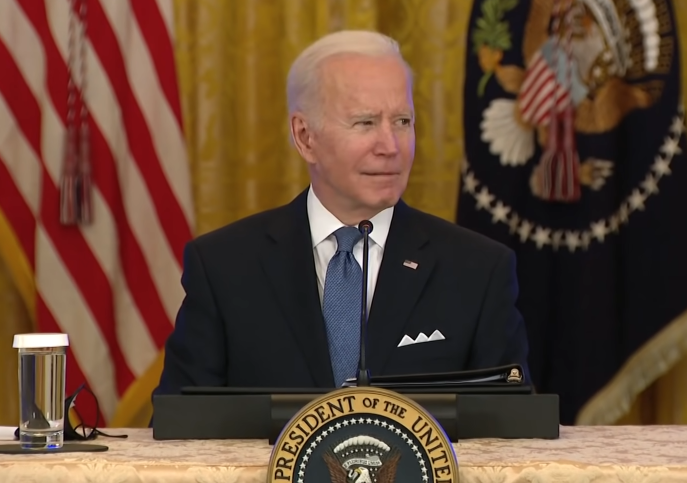Inflation over the past 12 months has crashed to 3 percent in June according to the latest data from the Bureau of Labor Statistics after a massive uptick following the more than $6 trillion that was printed, borrowed and spent into existence for Covid coupled with the economic lockdowns and production halts—literally too much money chasing too few goods.
As a result, inflation rose from just 1.4 percent annualized in Jan. 2021 when Biden took office to 5.4 percent by June 2021, to 7.5 percent by Jan. 2022 right before Russia invaded Ukraine and peaking at 9.1 percent in June 2022 before it finally took its toll, the economy overheated, Americans maxed out their credit cards and demand began to sink.
The drop is owed entirely to the June 2022 reading of 9.1 percent falling off the 12-month chart, when inflation grew 1.3 percent for all items in a single month, including a 60 percent increase in gasoline, a 98 percent increase in fuel oil and a 38 percent increase in piped gas service after Russia invaded Ukraine in Feb. 2022, further exacerbating the global supply chain crisis as oil and energy markets were severely impacted.
As a result, gasoline is down 26.5 percent the past 12 months, fuel oil is down 36.6 percent and piped gas service is down 18.6 percent.
But with those energy price spikes now in the rear view mirror, core inflation still remains quite sticky, that is, inflation minus food and energy, still coming in at 4.8 percent the past 12 months.
In fact, prices are still way up almost everywhere else, with the current slowdown in prices owed no thanks food, the prices of which have grown by 5.7 percent the past 12 months.
Electricity is still up 5.4 percent the past year.
New cars are up 4.1 percent.
Medical care commodities are up 4.2 percent.
Shelter is up a whopping 7.8 percent.
And transportation services are up 8.2 percent.
Another important fact to consider is that through almost all of the price hikes, wages did not keep pace with the price hikes, as consumer prices grew faster than nominal wages as measured by the Bureau of Labor Statistics.
In Jan. 2021, average weekly earnings were growing at 7.36 percent annualized, dropping to 4.55 percent in June 2021 as millions more reentered the labor force and staying down there at 4.8 percent by June 2022.
Until finally, with annualized inflation down to 3 percent currently, wages have caught up, growing at 3.7 percent over the past twelve months. That makes June 2023 the first time since March 2021 that has happened, although the mismatch between earnings and inflation during Covid can easily be discounted.
25 million jobs were lost by April 2020 to the lockdowns and production slowdowns, particularly hitting lower wage workers. Those who lost their jobs weren’t counted in the survey. Suffice to say by the end of 2020, more than 16 million jobs had been recovered and through 2021, as the economy more fully reopened, the impact of the inflation against wages could be seen.
That was more than two years where Americans were effectively getting poorer by the measure of wages versus inflation, and now, briefly, for a single month, Americans can get their heads above water. But to make a real difference, incomes will need to grow faster than consumer prices for years in order to catch up.
Unemployment is still near record lows, currently at 3.6 percent in June and the Federal Reserve is projecting it to keep rise steadily to 4.1 percent this year and up to 4.5 percent in 2024, an implied 1.3 million jobs losses between then and now, as it sees inflation continuing to cool off from its current levels.
But the sticky inflation remains, the volatility of energy markets notwithstanding, and could see prices on the 12-month chart once again rising above their current level going forward. That is, depending on what the Fed does with interest rates moving forward. In June, it held the Federal Funds Rate steady at 5 percent to 5.25 percent, but it also said “additional policy firming” might be necessary: “In determining the extent of additional policy firming that may be appropriate to return inflation to 2 percent over time, the Committee will take into account the cumulative tightening of monetary policy, the lags with which monetary policy affects economic activity and inflation, and economic and financial developments.”
The truth is, the inflation might already be out of the system but for whatever reason, the Fed did not begin hiking rates until inflation had already reached 7.5 percent by Feb. 2022 prior to Russia’s invasion of Ukraine. It was at least a year late to the call, lulled into complacency by Bernankean zero-bound interest rates and overestimating the long-term impacts of the Covid recession.
And with inflation still bleeding into non-energy areas, especially food, shelter and medical commodities, more rate hikes may be in store as the economy continues to overheat and American households tighten their belts. That will continue until either the higher interest rates break the back of the inflation, a recession ensues, or both. As usual, stay tuned.
Robert Romano is the Vice President of Public Policy at Americans for Limited Government Foundation.







